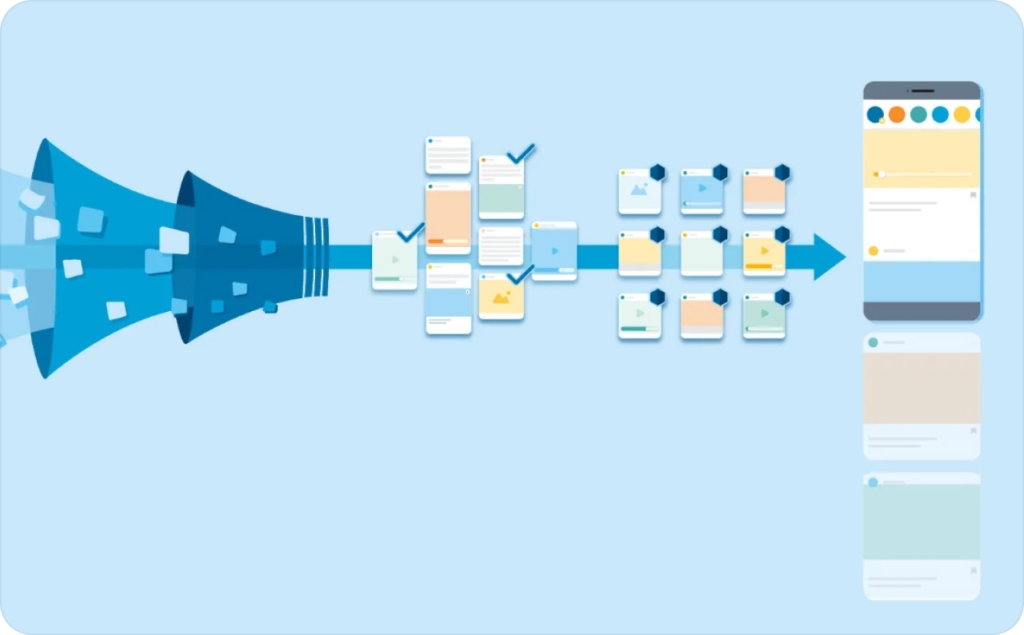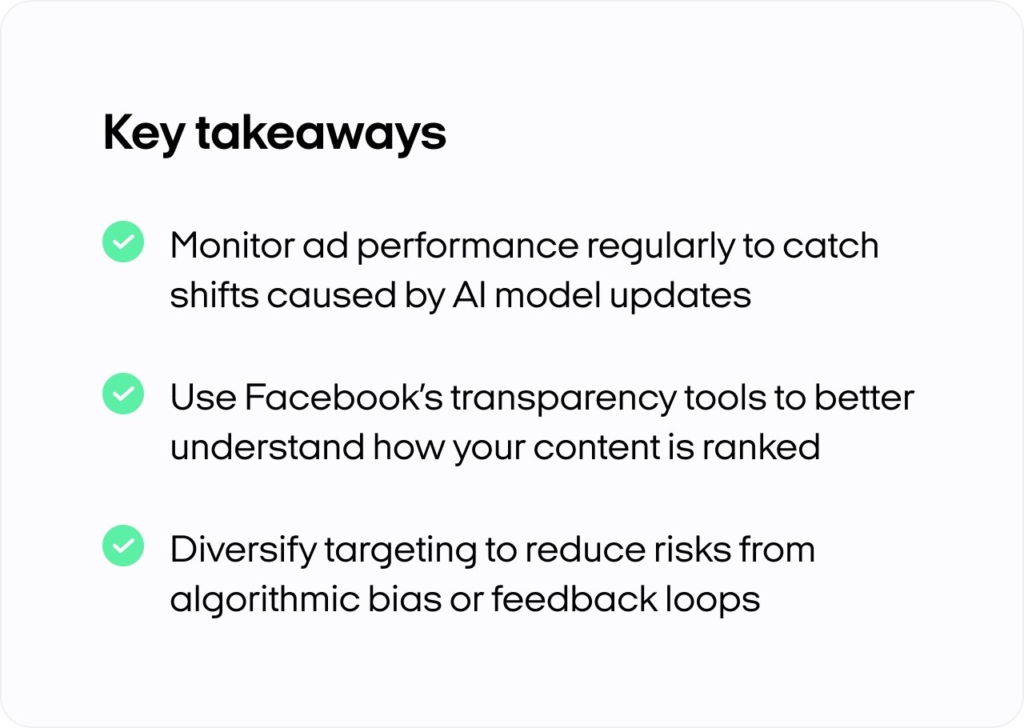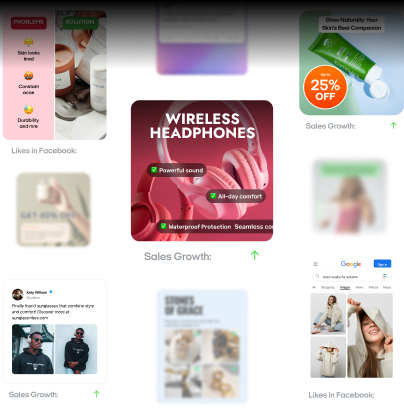How Facebook use AI to make your ads 61% more effective
Facebook’s AI decisions affect over 2.5 billion users — are you using this powerful system effectively for your business?
Facebook’s AI shapes what you see, which ads you click, and how businesses reach their best customers, driving personalized content and targeted ads at scale.
From ad campaigns that boost sales by up to 61% to algorithms that instantly adapt to user interests, in this blog post you’ll discover exactly how Facebook’s AI works, why it impacts your marketing, and how to harness it for better results.

Why Facebook shows you certain posts and knows what you like
Ever wonder how Facebook’s feed seems to read your mind? It’s not luck — it’s powered by machine learning classifiers. It predicts which posts you’ll like based on your past actions.
As of September 2024, Mark Zuckerberg revealed that Meta AI serves around 500 million monthly users, while Facebook as a whole surpasses 2.5 billion. These content recommendation engines scan billions of clicks, likes, and comments to highlight posts that match your interests.
Why do you see some posts first? Facebook’s feedback loops watch how long you look at stories or ads, learn from that data, then optimize feed ranking to show more content you might enjoy.
A feedback loop means the AI quickly adjusts your feed based on each scroll, click, and reaction. These same systems shape ad targeting, helping brands reach the right audience without wasting money.
If you linger on workout videos, for instance, you might spot a “7-day fitness challenge” ad — one that could lead to 22% more sign-ups than a basic “Sign up” button.
Some folks question algorithm transparency and whether they see too many promotions. But Facebook uses supervised learning to track what users find engaging or harmful.
“Supervised” means the AI system is trained on real examples, like which ads get reported and which posts get likes, so it learns what to show or hide. For small business owners, understanding this system can help you craft better ads and reach people who actually need your products or services.
Now that you know why your feed looks the way it does, let’s see how Facebook’s AI got here — moving from early ranking formulas to the advanced machine learning it uses now.

Photo source: Meta
How Facebook’s AI got smarter over time
Facebook launched its News Feed in 2006, revolutionizing how users discovered new updates. No more visiting each friend’s profile — one scroll showed you all the latest posts.
As the platform ballooned, it needed a system to organize the flood of content. Enter EdgeRank, the first feed ranking algorithm. It scored each “edge” (post) by how close you were to the friend who posted, how recent the content was, and how often you interacted.
At first, EdgeRank felt transformative. It hid less-relevant items and let you see what mattered most. Yet it missed deeper behaviors, like how long you watched a video or whether you came back days later to leave a comment.
As photos, groups, and business pages expanded, EdgeRank’s static approach couldn’t keep up. It was like using a small filing box to organize a massive warehouse.
How Facebook learns what you want to see
To replace EdgeRank, Facebook introduced FB Learner, a platform designed to train and deploy advanced machine learning classifiers on a huge scale.
Rather than rely on one formula, FB Learner tests countless content recommendation models and updates them in real time. It checks how long you watch Reels, whether you share posts, and even if you skip ads after two seconds.
This continuous improvement is the core of feedback loops: the AI sees how you behave and adapts almost instantly.
A real-world example? When testing short Reels versus longer videos, Facebook noticed people spent 15% more time on short clips with captions. This should be taken into account when creating UGC-style video ads with AI, while setting the ad duration.
Through FB Learner, the feed algorithm started favoring those fast-paced Reels. For small businesses, this means your ad or video has a better shot at reaching viewers who love quick, punchy content.
With the rise of Meta AI, Facebook also unites research across Instagram and other apps. Experts like Joaquin Quiñonero Candela refined these algorithms by blending data science with user psychology.
In other words, they look at what truly hooks people — like certain topics, video lengths, or even call-to-action words. This goes beyond simple feed curation, powering ad optimization that predicts who’s most likely to click or convert. It’s why you might see a 10% spike in sales after targeting users who already watch product demos.
Over time, Facebook’s AI progressed from a basic ranking system to a global content personalization ecosystem. By running repeated A/B tests, analyzing user feedback, and integrating cross-platform insights, the platform keeps you scrolling, clicking, and engaging.
How AI on Facebook & Instagram personalizes content for you
According to The Verge, Meta uses 22 AI-driven system cards to explain how they personalize your Facebook and Instagram experience. These systems follow a clear process: gather possible content, check your behavior signals, then rank what you see.
For example, if you pause on vacation photos, you’ll get more travel-related posts. If you scroll past home workout videos, the system adjusts and shows fewer of them.
Let’s say you run a small brand that sells planners and you created a UGC video with Facebook ad creator to promote your product on Meta networks. If a user has engaged with similar products or clicked on organizing tips, Meta’s content recommendation engine may rank your post higher for that user. This is how AI systems help your content find the right person at the right time.
But personalization isn’t just about fun posts. It’s also about safety. AI models like SimSearchNet scan billions of photos and videos each day to spot misinformation or hate speech. In one quarter of 2020, AI detected 88.8% of hate speech that was removed.
That same quarter, Facebook added warning labels to about 50 million COVID-19 posts. Still, some content — like memes that combine text and images — slipped through. To improve detection, Meta built a 10,000-example meme dataset to train smarter AI.
Why AI chooses certain Feeds, Stories, and Reels for you
Facebook and Instagram use feed ranking algorithms that learn from what you engage with. These systems look at watch time, likes, skips, and how often you comment.
When you stop and watch a short cooking video, the AI sees it, and bumps similar content to the top of your feed. This matters for small businesses.
Imagine you’re promoting a skincare product and want to avoid costly mistakes with smart ad creative automation. If your customer recently interacted with “morning routine” tips or beauty Reels, your ad has a higher chance of being shown. Meta’s AI works like a matchmaker by pairing your content with the right viewers.
Stories and Reels use similar signals. If you always tap through one creator’s Stories, you’ll see them first. If you ignore a topic, like sports clips or meme pages, the system learns that and shows less of it.
How you can customize and control your feed
To help, Meta created tools that give you more control. You can now click “Interested” or “Not Interested” to shape what shows up next.
Let’s say you keep seeing product reviews but want more behind-the-scenes content. By tapping “Not interested,” you teach the algorithm to remove that type of content from your feed.
For marketers, this matters too. If someone marks your content as “Interested,” that user is more likely to convert.
Beyond that, Meta launched transparency tools like system cards and the Content Library to show how AI rankings work. These are especially useful for researchers and advertisers.
And to keep your feed safe, AI and human moderators work together to stop harmful content — like hate speech and misinformation — before it spreads.
How Facebook’s AI helps you reach the right customers
Now that you’ve seen how AI personalizes feeds on Facebook and Instagram, let’s explore how it transforms ad campaigns. Meta owns both platforms and develops the AI tools that power these experiences, while Facebook serves as a primary surface for your ads.
Just like your feed uses frameworks like Lattice or DeepText to tailor recommendations, the same technology identifies potential customers for your campaigns by analyzing billions of signals.
Many advertisers find Facebook unpredictable, but Meta’s AI-driven ad targeting reduces guesswork. In fact, Meta recently introduced features for WhatsApp ads, showing how AI is expanding across all its platforms. Over 80% of industry experts now use some form of AI for ad targeting or lead generation — and Facebook’s system is a prime example of why it works.
Meta provides transparent metrics, like conversions and click-through rates—so you can track success. AI refines your bids, audience segments, and ad timing behind the scenes, predicting who might convert soon.
By monitoring these performance metrics, you’ll spend less time guessing and more time improving your creative or testing new audiences.
How Facebook’s AI knows who should see your ads
Facebook ads optimization and algorithms hinges on two concepts: Estimated Action Rate and Ad Quality. Estimated Action Rate predicts how likely someone is to click or buy, based on past engagement and online habits. Ad Quality reflects how relevant your ads are — if people hide them or give negative feedback, your ranking drops.
The moment you successfully launch a campaign, AI ad optimization studies both metrics to match your ads with high-intent viewers. Suppose you sell eco-friendly phone cases.
If your ideal customers often search “sustainable products,” Facebook pinpoints that pattern and shows them your ads first. This lowers wasted impressions and boosts your chance of a sale.
What real brands learned from using AI ads
Social Media Today’s case studies with solid data prove how effective Facebook’s AI can be.
For instance, Pandora Jewelry adapted a TV ad to Facebook for German audiences, boosting brand favorability by 10 points, raising purchases by 61%, and attracting 42% more new buyers.
Meanwhile, Tomcat ran a horror-themed live video event with viewer interaction, netting 2.3 million views and a 58% fan increase.
FoxNext Games tested carousel versus video ads and saw 61% more installs plus a 33% lower cost per install using carousel.
Samsung gained a 500% ROI and 7% more new customers through a multi-video campaign in Argentina. These success stories show that conversion optimization guided by AI can turn average campaigns into standout winners.
What you need to know about Facebook’s AI problems
By now, you’ve seen how Facebook’s AI fuels personalization and ad targeting. But every innovation has its drawbacks. Many users and advertisers worry about algorithm bias, data privacy, and opaque decision-making that leaves them guessing how the system really works.
Ethical AI practices often lag behind rapid technological growth. If AI models rely on skewed data, they can produce unfair results — like favoring one group of users over another.
This lack of transparency isn’t just an ethical concern; it impacts advertisers who might unknowingly target or exclude certain audiences. Let’s look at where these challenges stand and how Facebook is trying to tackle them.
Why Facebook’s AI still feels like a mystery
People often ask: “How does Facebook’s AI make its decisions?” The truth is, the system can feel like a black box.
Algorithm transparency remains limited, even with features like “Why Am I Seeing This?” Because AI systems involve millions of data points, explaining every detail isn’t simple.
Critics say Facebook should do more to show how it ranks content and ads. Others point out that explainable AI might require a full redesign of current models.
While Meta has taken steps, like publishing system cards for certain features, some users and researchers still find these explanations too vague. This leaves a gap between rapid experimentation and a full understanding of what’s happening behind the scenes.
How AI can go off track without you realizing
Algorithm feedback loops can amplify problems if Facebook doesn’t catch them fast. Imagine a poorly trained classifier that flags innocent content as “spam.”
Over time, the system keeps learning from its own flawed decisions, making errors harder to fix. This also affects advertisers who see unpredictable ad performance, especially when changes roll out without clear announcements.
Rapid iteration is both a perk and a pitfall. AI can adapt on the fly, but updates may happen faster than user data privacy or regulatory compliance measures can keep up.
If you’re a creator or an advertiser, you might face sudden dips in reach or engagement for no clear reason. Facebook claims it’s working to mitigate algorithm bias by testing new model architectures and reviewing flagged content with human oversight, but full clarity is still a work in progress.

What’s next for Facebook’s AI and why it should matter
Despite these hurdles, Facebook’s AI continues to evolve. While Facebook is the platform where users and businesses interact, it’s Meta that leads the underlying research and development through initiatives like Meta AI and the FAIR (Facebook AI Research) team.
Their current focus is on generative AI and tools like Zeely AI or Llama, which are designed to improve how content is created, delivered, and personalized at scale.
Looking ahead, Meta plans to invest heavily in emerging AI technologies. This includes next-generation content ranking systems, safer large language models, and tools that can forecast user needs more accurately.
According to Meta’s 2024 roadmap, future innovations will also focus on increasing advertiser ROI while protecting user privacy and improving algorithm transparency.
As the social media industry shifts, the pressure to balance ethical AI with business performance is growing. Expect more discussion around regulatory compliance, especially in areas like ad fairness, content moderation, and user data usage.
Facebook’s AI is powerful, but it still has room to grow — especially when it comes to fairness, transparency, and user trust. With tools like Llama and support from research teams like FAIR, Meta is pushing to make its AI smarter, safer, and more aligned with how people and businesses actually use the platform.
Also recommended



